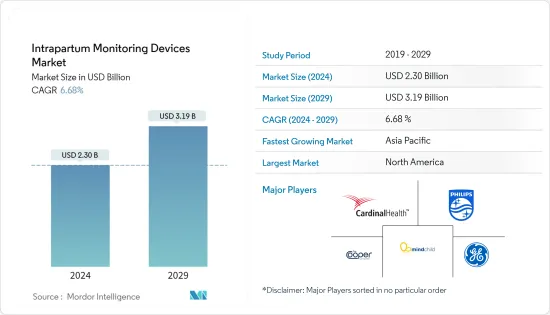
|
市場調査レポート
商品コード
1433478
分娩時モニタリングデバイス:市場シェア分析、産業動向・統計、成長予測(2024~2029年)Intrapartum Monitoring Devices - Market Share Analysis, Industry Trends & Statistics, Growth Forecasts (2024 - 2029) |
||||||
カスタマイズ可能
適宜更新あり
|
|||||||
| 分娩時モニタリングデバイス:市場シェア分析、産業動向・統計、成長予測(2024~2029年) |
|
出版日: 2024年02月15日
発行: Mordor Intelligence
ページ情報: 英文 80 Pages
納期: 2~3営業日
|
- 全表示
- 概要
- 目次
分娩時モニタリングデバイスの市場規模は、2024年に23億米ドルと推定され、2029年までに31億9,000万米ドルに達すると予測されており、予測期間(2024年から2029年)中に6.68%のCAGRで成長します。

世界の乳児死亡率と早産の増加により、分娩時モニタリングデバイス市場が推進されています。適切な妊産婦ケア施設へのアクセスの欠如と地域ごとの収入格差が、世界中の死亡率の差につながっています。新興諸国は、低所得層の存在、乳児ケア施設の不足、アンメットニーズにより、乳児死亡率という大きな課題に直面しています。 WHOの統計によると、効果的な産後ケア、出産ケア、母親ケアの存在により、未熟児の4分の3の生存が促進され、全体的な死亡率が低下します。さらに、マタニティケア機器の需要の増加も、予測期間中に市場を牽引すると予想されます。
分娩時モニタリングデバイスの市場動向
電極セグメントは分娩時モニタリングデバイス市場でさらなる成長を示すと予想される
製品タイプに基づいて、電極とモニターに分類されます。電極はさらに、子宮内圧カテーテル、胎児心拍数用のトランスデューサー、子宮収縮用のトランスデューサー、および胎児頭皮電極に分割されます。分娩時モニタリングの電極は、外部に取り付けられるか、モニタリングのために低侵襲性です。電極の急速な成長は、その高い普及率、早産の増加、女性の糖尿病症例の増加に起因すると考えられています。国際糖尿病連盟によると、2019年には出生6人に1人が妊娠糖尿病の影響を受けました。したがって、妊娠糖尿病の症例の増加により、これらのモニタリング装置に対する需要が高まり、予測期間に市場を牽引すると予想されます。
北米が分娩時モニタリングデバイス市場を独占すると予想される
現在、分娩時モニタリングデバイス市場は北米が独占しており、予測期間中も同じ傾向が続くと予想されます。この地域が優勢なのは、婦人科糖尿病の有病率の上昇と肥満の増加に起因すると考えられます。婦人科糖尿病に苦しむ女性は、分娩時の問題や早産になりやすい傾向もあります。アメリカ疾病予防管理センター(CDC)によると、2017年の早産率は出生数の9.93%で、2016年の9.85%から若干上昇しました。したがって、これらの疾患の有病率の増加により、北米における分娩内モニタリング市場が促進されると予想されます。
分娩時モニタリングデバイス業界の概要
分娩時モニタリングデバイス市場における世界のプレーヤーは、Analogic Corporation、Cardinal Health、Cooper Companies, Inc.、GEヘルスケア、Koninklijke Philips NV、Medtronic PLC、MindChild Medical、Olympus Corporation、Stryker Corporationです。
その他の特典
- エクセル形式の市場予測(ME)シート
- 3か月のアナリストサポート
目次
第1章 イントロダクション
- 調査の成果
- 調査の前提
- 調査範囲
第2章 調査手法
第3章 エグゼクティブサマリー
第4章 市場力学
- 市場概要
- 市場促進要因
- マタニティケアデバイスの需要増加
- 早産と乳児死亡率の増加
- 市場抑制要因
- アクセシビリティと手頃な価格に関する問題
- 厳しい規制ガイドライン
- ポーターのファイブフォース分析
- 新規参入業者の脅威
- 買い手/消費者の交渉力
- 供給企業の交渉力
- 代替品の脅威
- 競争企業間の敵対関係の強さ
第5章 市場セグメンテーション
- 製品タイプ別
- 電極
- 子宮内圧カテーテル(IUPC)
- 子宮収縮用トランスデューサ
- 胎児頭皮電極
- 胎児心拍用トランスデューサ
- モニター
- 電極
- 地域
- 北米
- 米国
- カナダ
- メキシコ
- 欧州
- ドイツ
- 英国
- フランス
- イタリア
- スペイン
- その他欧州
- アジア太平洋
- 中国
- 日本
- インド
- オーストラリア
- 韓国
- その他アジア太平洋地域
- 中東・アフリカ
- GCC
- 南アフリカ
- その他中東とアフリカ
- 南米
- ブラジル
- アルゼンチン
- その他南米
- 北米
第6章 競合情勢
- 企業プロファイル
- Analogic Corporation
- Cardinal Health
- GE Healthcare
- Koninklijke Philips N.V.
- Medtronic PLC
- MindChild Medical
- Olympus Corporation
- Stryker Corporation
- The Cooper Companies, Inc.
第7章 市場機会と今後の動向
The Intrapartum Monitoring Devices Market size is estimated at USD 2.30 billion in 2024, and is expected to reach USD 3.19 billion by 2029, growing at a CAGR of 6.68% during the forecast period (2024-2029).

The rise in infant mortality and preterm births globally are propelling theintrapartum monitoring devicesmarket. The lack of access to appropriate maternal care facilities and disparities of income in different regions leads to a difference in mortality rates across the world. The developing countries face the greater challenges of infant mortality owing to the presence of lower-income groups, lack of infant care facilities, and unmet needs for obstetric care. According to the statistics of WHO, the presence of effective postnatal, natal, and maternal care can facilitate the survival of 3 quarters of premature babies reducing the overall mortality rate. Moreover, increasing demand for maternitycare devices is also expected to drive the market over the forecast period.
Intrapartum Monitoring Devices Market Trends
Electrodes Segment is Expected to Show Better Growth in the Intrapartum Monitoring Devices Market
Based on product type, it is segmented into electrodes and monitors. The electrodes are further segmented into an intrauterine pressure catheter, a transducer for Fetal Heart Rate, a transducer for uterine contractions and fetal scalp electrodes. The electrodes in intrapartum monitoring are either externally attached or minimally invasive for monitoring. The high growth of the electrodes is attributed to their higher adoption rates, rising preterm birth, and increasing diabetes cases in women. According to the International Diabetes Federation, 1 in 6 births was affected by gestational diabetes in 2019. Hence, the rising cases of gestational diabetes mellitus lead to high demand for these monitoring devices and is expected to drive the market in the forecast period.
North America is Expected to Dominate the Intrapartum Monitoring Devices Market
North America currently dominates the intrapartum monitoring devices market and is expected to continue the same trend in the forecast period. The dominance of this region can be attributed to the rising prevalence of gynecological diabetes mellitus, and growing cases of obesity. The women suffering from gynecological diabetes mellitus are also prone to intrapartum issues and preterm deliveries. According to Centers for Disease Control and Prevention (CDC), in 2017 the premature birth rate was 9.93 percent of births, up slightly from 2016, when it was 9.85 percent. Hence, increasing prevalence of these diseases is expected to drive the market for intrapartum monitoring in North America.
Intrapartum Monitoring Devices Industry Overview
The global players in the intrapartum monitoring devices market are Analogic Corporation, Cardinal Health, Cooper Companies, Inc., GE Healthcare, Koninklijke Philips N.V., Medtronic PLC, MindChild Medical, Olympus Corporation and Stryker Corporation.
Additional Benefits:
- The market estimate (ME) sheet in Excel format
- 3 months of analyst support
TABLE OF CONTENTS
1 INTRODUCTION
- 1.1 Study Deliverables
- 1.2 Study Assumptions
- 1.3 Scope of the Study
2 RESEARCH METHODOLOGY
3 EXECUTIVE SUMMARY
4 MARKET DYNAMICS
- 4.1 Market Overview
- 4.2 Market Drivers
- 4.2.1 Increasing Demand for Maternity Care Devices
- 4.2.2 Rising Preterm Birth and Infant Mortality
- 4.3 Market Restraints
- 4.3.1 Issues Associated with Accessibility and Affordability
- 4.3.2 Stringent Regulatory Guidelines
- 4.4 Porter's Five Forces Analysis
- 4.4.1 Threat of New Entrants
- 4.4.2 Bargaining Power of Buyers/Consumers
- 4.4.3 Bargaining Power of Suppliers
- 4.4.4 Threat of Substitute Products
- 4.4.5 Intensity of Competitive Rivalry
5 MARKET SEGMENTATION
- 5.1 By Product Type
- 5.1.1 Electrodes
- 5.1.1.1 Intrauterine Pressure Catheter (IUPC)
- 5.1.1.2 Transducer for Uterine Contractions
- 5.1.1.3 Fetal Scalp Electrodes
- 5.1.1.4 Transducer for Fetal Heart Rate
- 5.1.2 Monitors
- 5.1.1 Electrodes
- 5.2 Geography
- 5.2.1 North America
- 5.2.1.1 United States
- 5.2.1.2 Canada
- 5.2.1.3 Mexico
- 5.2.2 Europe
- 5.2.2.1 Germany
- 5.2.2.2 United Kingdom
- 5.2.2.3 France
- 5.2.2.4 Italy
- 5.2.2.5 Spain
- 5.2.2.6 Rest of Europe
- 5.2.3 Asia-Pacific
- 5.2.3.1 China
- 5.2.3.2 Japan
- 5.2.3.3 India
- 5.2.3.4 Australia
- 5.2.3.5 South Korea
- 5.2.3.6 Rest of Asia-Pacific
- 5.2.4 Middle-East and Africa
- 5.2.4.1 GCC
- 5.2.4.2 South Africa
- 5.2.4.3 Rest of Middle-East and Africa
- 5.2.5 South America
- 5.2.5.1 Brazil
- 5.2.5.2 Argentina
- 5.2.5.3 Rest of South America
- 5.2.1 North America
6 COMPETITIVE LANDSCAPE
- 6.1 Company Profiles
- 6.1.1 Analogic Corporation
- 6.1.2 Cardinal Health
- 6.1.3 GE Healthcare
- 6.1.4 Koninklijke Philips N.V.
- 6.1.5 Medtronic PLC
- 6.1.6 MindChild Medical
- 6.1.7 Olympus Corporation
- 6.1.8 Stryker Corporation
- 6.1.9 The Cooper Companies, Inc.


